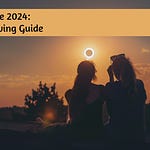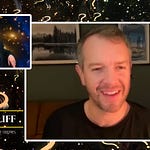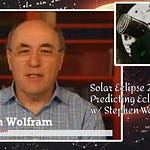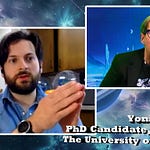Hello everyone!
Welcome back to The Cosmic Companion. I’m James Maynard!
This week, we look at the one thing every space traveler will have in common — they will all be Living with a Body in Space. Later in the show, we will be joined by Christina Sauer, Associate Editor for National Geographic Kids, talking about their new release, Why? The Human Body.
For the foreseeable future, people venturing out exploring the final frontier are more than likely to have bodies of one form or another. At least until the whole brain-in-a-jar thing is perfected.
Human bodies evolved on Earth, so our bodily systems are designed, more or less, to function on our home planet. This is not necessarily good news for those headed to the Moon or Mars.
Listen to the podcast version of this episode here, or watch is as a video!
Why, howdy, Pardner! I’m Risky Ridge, rancher here at Risky Ridge Ranch. Seein’ you planet-slickers stepping out into space here… we’ll, I reckon’ a fella’ jus’ hasta help ya out ‘fer you get yourselves messed up in all licks o’ trouble.
I’m an ol’ hand out here at Risky Ridge Ranch. If you’re lookin’ to stay outta danger best’n ya can, and know what sorta risk you’re wrestlin’ with out here, this is the word you’re lookin’ to remember. It’s Ridge. Like me, Risky Ridge.
R is Space Radiation, I is your Isolation and Confinement there, and D gives you your Distance from Earth… Are you listenin’ there? Pay attention, now! You got your Gravity fields for G, and E is standin’ in fer Hostile/Closed Environments, which don’t sound the least bit ‘tractive, if’n yer askin’ me.
Also, space cows are the gen-u-ine deal out here, you can count on it. So, just be watchin’ where your steppin’. Wouldn’t wanna mess up your fancy Earth boots. They sure iz purty…
I gotta head off now, pardner. But next time you’re out in space, you look up your buddy Risky Ridge. Yee-hawwww!!!
As Risky goes riding off into the sunset, we welcome Christina Sauer, Associate Editor for National Geographic Kids to the show, talking about their new release, Why? The Human Body.
Let’s poke on down through the risks of RIDGE!
First up is R — space radiation. This is EXACTLY as desirable as it sounds.
The Apollo missions of the 1960s and 70s were the only times, so far, that human beings have traveled beyond the protective Van Allen radiation belts of Earth. If all goes to plan, that will soon change with the flight of Artemis 2.
Here on Earth, these giant doughnuts in space (Mmmmm…) and our atmosphere protect us against most harmful radiation from the Sun and elsewhere in space.
However, people and animals traveling beyond low-Earth orbit will face cosmic rays, radiation from coronal mass ejections (or CMEs) erupting from the Sun, and wayward ionized atomic nuclei and free electrons.
This radiation salad increases risks from cancer, central nervous system damage, and changes to DNA.
Shielding — either from structures or by being buried in alien landscapes — will be needed for spacecraft and habitations of the future.
Isolation is a very real problem in space, as crews currently top out at six or seven people.
As more people reach space, however, communities and civilizations will grow. The need to work together to survive will tie these interplanetary villages together, reducing the effects of isolation in these far-flung hamlets.
Got the sniffles? House calls from doctors aren’t even a thing anymore in the US, never mind in a space station orbiting the Moon. That lack of access to Earth and its troves of medicines due to distance is D. (You remember that, right? Good.).
G — Gravity. Got dreams of living in space? A lack of gravity can certainly bring you down, ironically.
Gravitational forces on the Moon are just 1/6th of what they are on Earth, while standing on Mars would have you weighing in at just one-third what you do on our home planet. This may sound like a great weight loss plan. It’s not.
Just a few minutes of exposure to microgravity can cause bodily fluids to swell up in your upper body, giving you that oh-so-attractive chipmunk look.
[[Mandragora, I can no longer sit back and allow microgravity infiltration, microgravity indoctrination, microgravity subversion, and the international microgravity conspiracy to sap and impurify all of our precious bodily fluids…]]
Space travelers lose bone density and muscle mass over time, can suffer vision problems. Exercise and proper nutrition can help mitigate some of these issues, but they present serious challenges for the long-term habitation of space.
Finally — [CHEER] Gimme an E — That’s all I got. Closed and Hostile Environments. Being cooped up in a tiny habitat with 8 other people, 385,000 kilometers from Earth might seem like quite a getaway until a virus starts going around.
Recycling air and water aboard spaceborne habitations is going to remain a necessity, at least for the foreseeable future. But improvements to these systems, and the extra space provided by larger outposts should work to overcome these challenges.
The risks of RIDGE present obstacles to the large-scale permanent habitation of space. However, these challenges can be overcome in whole or part through technology, and the movement of more people into the Cosmos, bringing our species beyond our planetary birthplace.
Next week on The Cosmic Companion, we will be Planting the Seeds of STEAM, talking with Ariane Szu-Tu, senior editor, National Geographic Kids Books. Make sure to join us starting on 1 July.
The following week — 8 July — is our half-season finale. We are looking at The Greatest Mysteries of the Universe. We will be joined by acclaimed physicist and author Lawrence Krauss, author of The Physics of Star Trek, discussing his new work, The Edge of Knowledge.
Take a ride on over to TheCosmicCompanion.com or .net, sign up for our newsletter, and we’ll rustle up every episode into your email inbox every week.
Clear skies!
James
























Living with a Body in Space with Christina Sauer, Associate Editor, National Geographic Kids